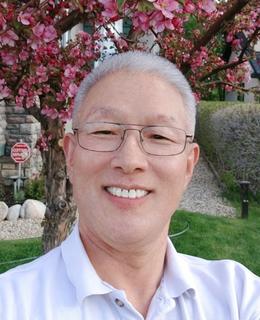
Dr. Ki-Young Lee
Positions
Professor
Cumming School of Medicine, Department of Cell Biology and Anatomy
Associate Member
Hotchkiss Brain Institute
Child Health & Wellness Researcher
Alberta Children's Hospital Research Institute
Contact information
Phone number
+1 (403) 220-8723: +1 (403) 210-6637
Location
Office: HM359
For media enquiries, contact
Kelly Johnston
Senior Communications Specialist
Please submit your media request here
Background
Educational Background
Doctor of Philosophy, Microbiology and Molecular Biology, University of California, Davis, 1990
Postdoctoral Fellow, Cancer Biology, Stanford University, 1993
Biography
Dr. Lee is currently a tenured Full Professor in the Dept. of Cell Biology and Anatomy, Cumming School of Medicine (CSM) at the University of Calgary. Dr. Lee joined the CSM after completing his Ph.D. at the University of California in Davis and postdoctoral training at Stanford University and the University of Calgary as an Alberta Heritage Foundation for Medical Research (AHFMR) Fellow. Currently, he is a full member of the Arnie Charbonneau Cancer Institute and the Alberta Children's Hospital Research Institute (ACHRI) and an associate member of the Hotchkiss Brain Institute (HBI). Dr. Lee is an established investigator and has been well-funded by the CIHR, NSERC, CBCF, Alzheimer’s Association (USA), and other granting organizations. He is known for his pioneering research and significant contributions in the field of cyclin-dependent kinase 5 and L-asparaginase resistance biomarkers in acute lymphoblastic leukemia that led to many publications in very well respected peer-reviewed international scientific journals. Dr. Lee has been invited to serve as Topic Editor, Biomarkers and Therapeutic Strategies in Acute Lymphoblastic Leukemia, for the Frontiers in Cell and Developmental Biology.
Research
Areas of Research
My research interest is to elucidate how cyclin-dependent kinase 5 (cdk5) and its related protein, cdk5 regulatory subunit-associated protein 2 (cdk5rap2), regulate specialized cell functions. The major questions that I wish to address are: how they are regulated, what their downstream targets are, how they interact with these targets, and how they are involved in diverse signaling pathways to drive and regulate cellular events. My recent studies suggest that cdk5rap2 plays a role in primary microcephaly and primordial dwarfism. Interestingly, I also found that depletion of cdk5rap2 induces senescence-like phenotype. My hypothesis is that cdk5rap2 is required for neural stem cell (NSC) self-renewal and loss of cdk5rap2 promotes senescence. Thus, my goal is to elucidate the significance of cdk5rap2 in NSC self-renewal and how its loss induces senescence. To pursue this objective, I am utilizing gain- and loss-of function analyses in two well-established human NSC derived from developing human brains in conjunction with modern and conventional techniques in cell and molecular biology and biochemistry. Results from my investigations will significantly advance our knowledge on the fundamental cell and molecular biology of stemness and senescence.
I am also interested in the identification of resistance biomarkers for L-asparaginase, a critical component of acute lymphoblastic leukemia (aLL) chemotherapy. By unbiased genome-wide RNAi screening, my group discovered opioid receptor mu 1 (OPRM1) and huntingtin-associated protein 1 (HAP1) as L-asparaginase resistance biomarkers in aLL cells: absence leads to survival while presence leads to apoptosis. This points to OPRM1 and HAP1 as critical elements of novel non-canonical L-asparaginase-induced apoptotic pathways in aLL cells. HAP1 regulates ER Ca2+ release through inositol 1,4,5-trisphosphate (IP3)/IP3 receptor signaling, which can potentially be activated through the upstream protease-activated receptor 2 (PAR2). Conversely, OPRM1 activation is linked to reduced cAMP, which my group found to cause ER Ca2+ release. Thus, I wish to define the mechanisms by which L-asparaginase induces PAR2- and OPRM1-mediated apoptosis in aLL cells with an ultimate goal of developing novel therapeutics for aLL.
Other ongoing research projects in my lab are: (i) to elucidate the molecular mechanism by which cdk5 regulates ROS and intracellular calcium release and (ii) to investigate the molecular basis for cdk5 loss/PARP1i synthetic lethality in breast cancers.
Participation in university strategic initiatives
Awards
- Featured Article, 2009
- AHFMR Research Prize ($ 100,000), 2004
- Strafford Foundation Chair in Alzheimer's Research Award ($ 40,000), 2003
- AHFMR Research Prize ($ 50,000), 2000
- Research Excellence Envelope, The University of Calgary ($ 50,000), 2000
- Certificate of Recognition for Outstanding Service on the Alzheimer's Association's Review Board of the Medical and Scientific Advisory Council, the Alzheimer's Association, Chicago, USA, 1999
- AHFMR Fellowship (1993-1996), 1993
- Alzheimer's Society of Canada Fellowship (1993-1996: Declined), 1993
Publications
More Information
In the past, I trained 5 visiting scientists, 1 research assistant professor, 14 PDFs, 10 graduate students, ~50 undergraduate students (who were mostly recipients of NSERC, AHFMR, ACB, or O’Brien Centre studentships), and 7 high school students. Many of my trainees are either first or co-authors in all publications from my laboratory, and many have gone on to become established faculty members, scientists or educators or physicians. Currently, I am supervising 1 research asst professor, 3 graduate students (2 PhD and 1 MSc) and 1 postdoctoral fellow.
In the past 15 years, I taught cellular, molecular and microbial biology 561 (CMMB 561) and medical science 561 (MDSC 561). This cancer biology course is offered to upper division undergraduate and graduate students from the Depts. of Biological Sciences and Medical Sciences as well as the Bachelor of Health Sciences program within the CSM. Student evaluations over the past 15 years of approximately 6.0 on a scale of 1.0 to 7.0 (7.0 being the highest rating) are indicative of his teaching excellence. In addition to CMMB 561 and MDSC 561, I taught and supervised various research courses, including MDSC 402, CMMB 507.27, CMMB 507.60, MDSC 508, MDSC 528, ZOO 530, CMMB 530, and an MD research specialization course at the University of Alberta. My other contributions to the scientific community include service as a member of the grant review panels for the CHIR, CBCF and the AHFMR PDF Review/Advisory Committee.
Are you the profile owner?
Login to edit.
